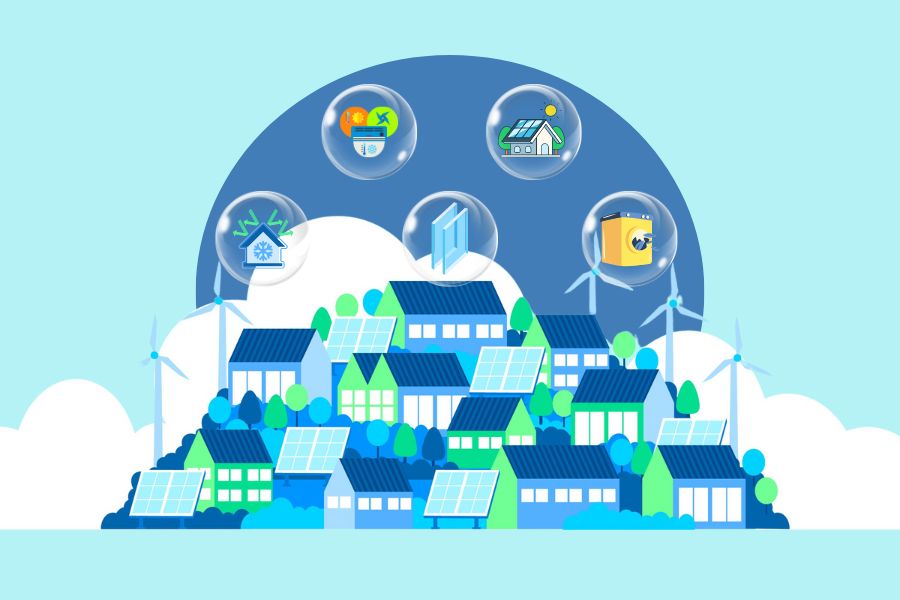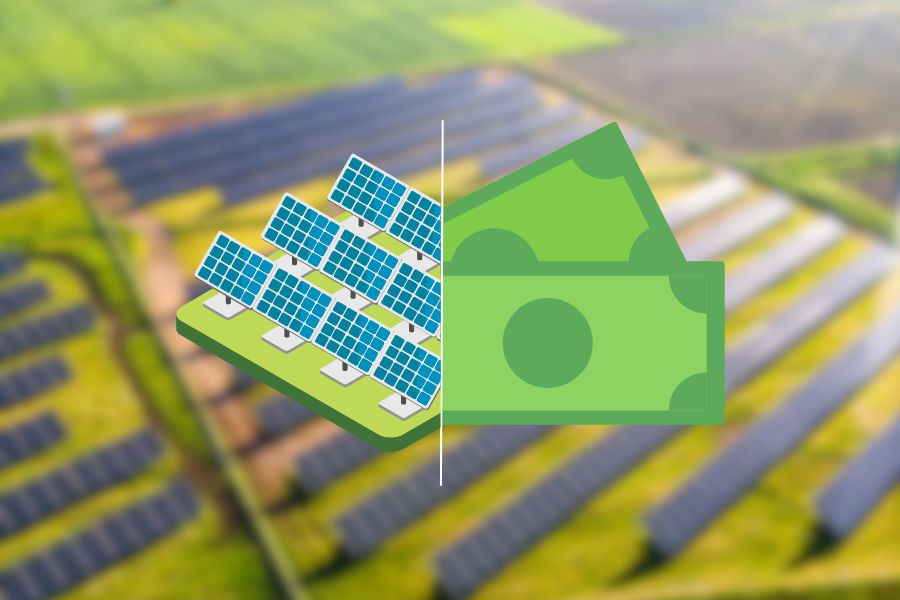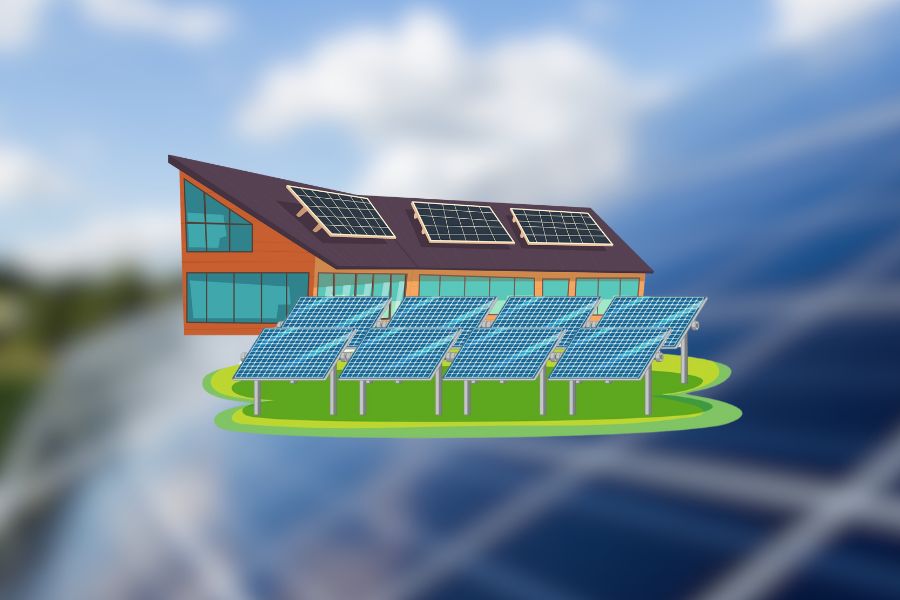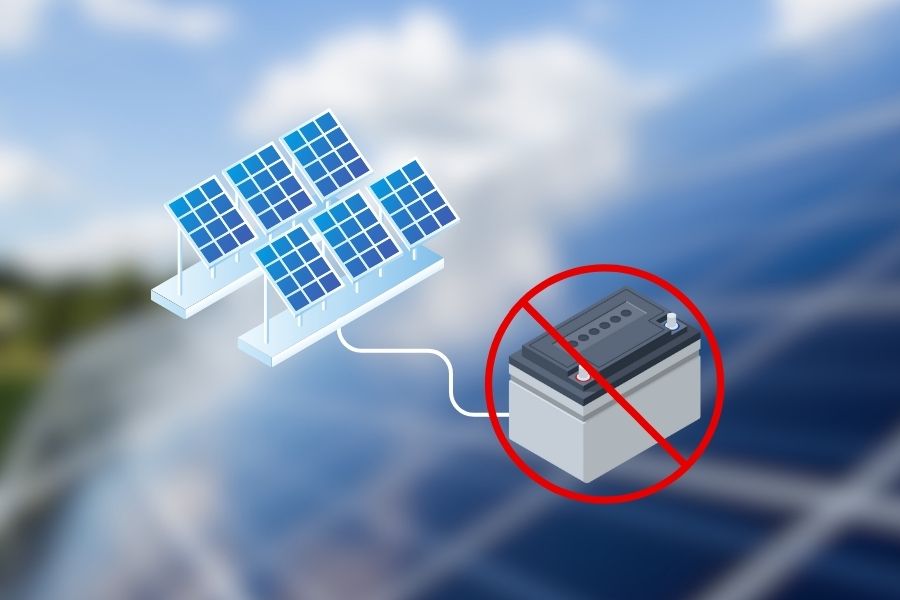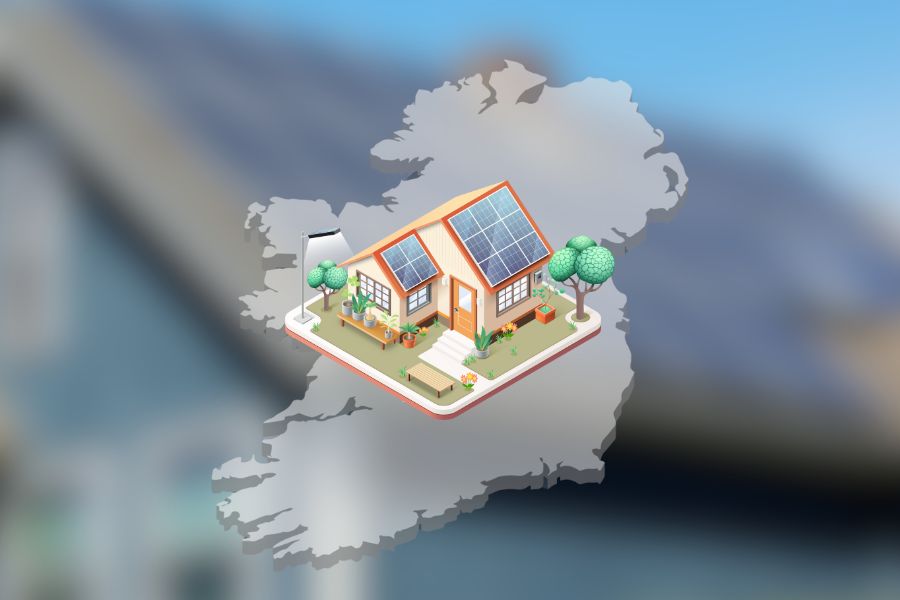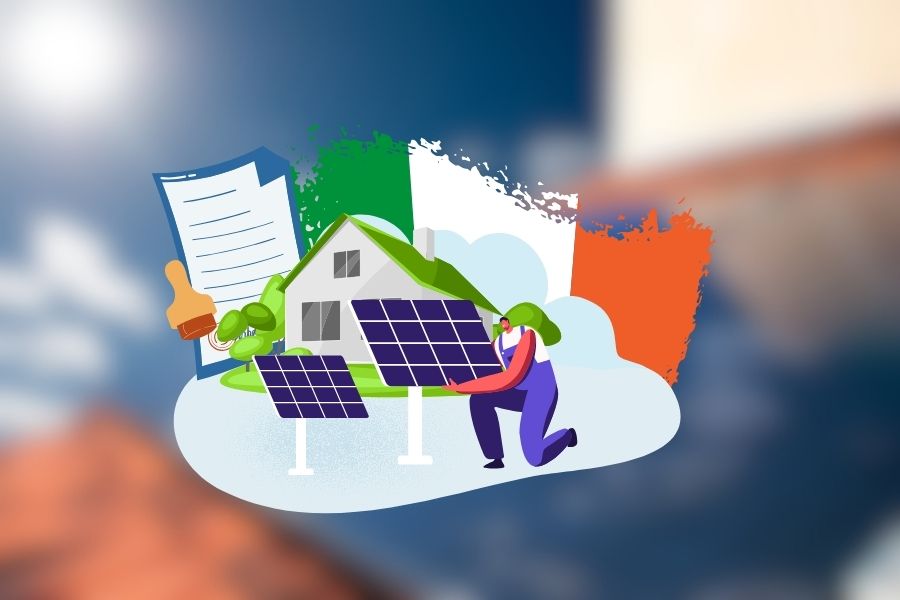The National Home Retrofit Scheme in Ireland is a government initiative to improve energy efficiency in homes, offering homeowners significant funding to carry out extensive retrofitting projects.
With this scheme, homeowners can receive financial support to upgrade insulation, install advanced heating control systems, and introduce other energy-saving measures to improve their Building Energy Rating (BER).
The process to avail of this scheme involves the following:
- Understanding if you qualify for the grants.
- Knowing the types of energy upgrade grants available.
- Following a specified application process.
The scheme reduces homeowners’ energy bills and contributes to Ireland’s broader environmental and economic goals. Now, let’s delve deeper into understanding this transformational scheme.
What Does Retrofitting a Home Mean?
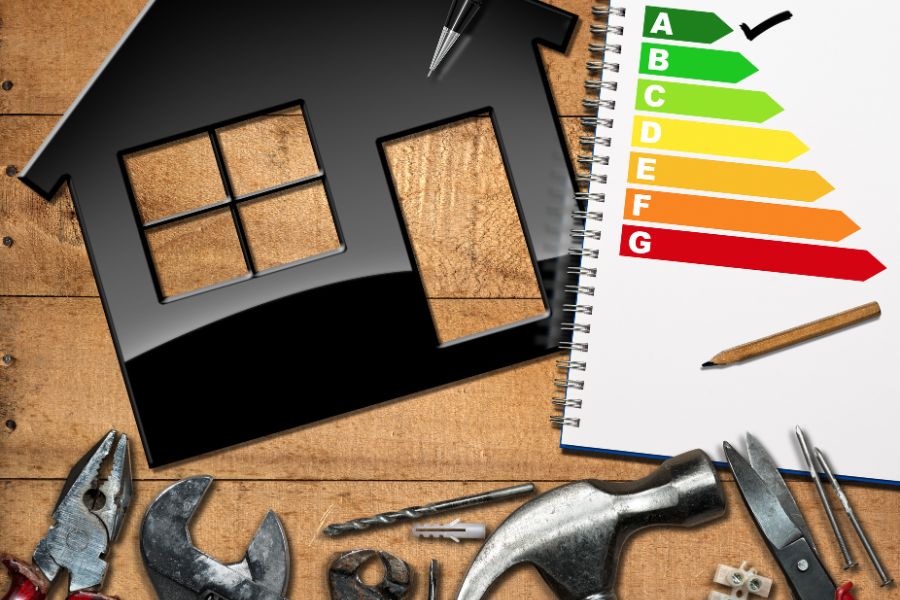
Retrofitting a home means undertaking home energy upgrades that equip it with new and improved features or technologies. The objective is not only to modernize the property but also to make it more energy-efficient and sustainable.
In the context of the National Home Retrofit Scheme in Ireland, which the Sustainable Energy Authority oversees, retrofitting might involve various changes to improve energy efficiency.
These can include enhancing insulation in the walls, roofs, or floors, swapping old windows with double glazing or high-performance alternatives, or integrating advanced heating and cooling systems.
Some homeowners might even undertake home energy upgrades like installing renewable energy solutions, such as solar panels. These changes reduce the home’s energy consumption and carbon footprint and have the added benefit of minimizing energy bills.
Beyond these financial and environmental perks, retrofitting can also ramp up the comfort levels in your home. Better insulation and heating systems mean more effective temperature regulation and improved indoor air quality.
Critical Elements of the National Home Retrofit Scheme
The National Home Retrofit Scheme in Ireland aims to upgrade Irish homes’ energy performance, reduce energy usage and emissions, and improve living conditions. Key elements of the scheme include:
- Funding: The system provides financial assistance to homeowners who wish to upgrade their homes to improve energy efficiency. They typically offer the budget as grants to cover some retrofit costs.
- Accreditation: Only certified contractors with the necessary skills and qualifications can perform the retrofitting work. It ensures high-quality, effective, and safe retrofits.
- Inspection and Evaluation: The scheme often requires a pre- and post-retrofit check. These evaluations ensure the improvements meet the necessary standards and effectively enhance energy efficiency.
Eligibility Criteria for Homeowners
To qualify for the Retrofit Scheme, homeowners must meet several eligibility criteria:
- Property Type: Generally, the scheme covers residential properties.
- Income: The system is available to all homeowners, regardless of income. However, some additional support may be available for lower-income households.
- Energy Audit: A professional energy audit is typically required. This audit identifies potential areas for improvement and determines which retrofits would be most cost-effective.
Types of Retrofits Covered by the Scheme
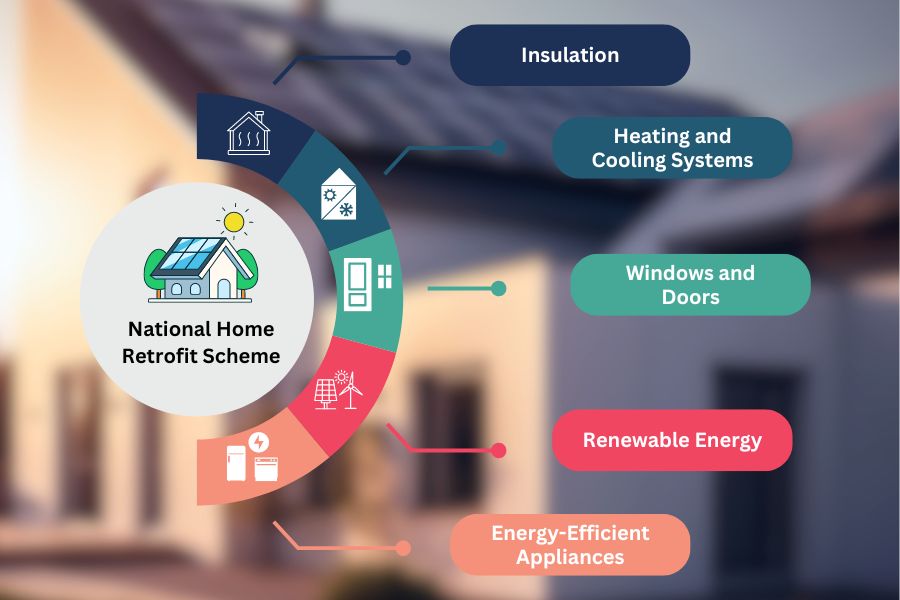
The scheme covers a variety of retrofits, including:
- Insulation: The plan covers upgrading or installing new insulation in walls, roofs, and floors.
- Heating and Cooling Systems: Homeowners can replace outdated, inefficient heating and cooling systems with more recent, energy-efficient models.
- Windows and Doors: The scheme supports installing double-glazed windows and well-insulated doors.
- Renewable Energy: Homeowners may install solar panels, heat pumps, or other technologies.
- Energy-Efficient Appliances: Upgrading to energy-efficient appliances can also be included in the retrofit.
What Does the National Home Retrofit Scheme Offer?
Grants for Energy UpgradesThe scheme provides grants that cover a substantial portion of the costs associated with home energy upgrades. These can include insulation improvements, installation of high-efficiency heating systems, and even the integration of renewable energy sources such as solar panels.
Technical Guidance
The scheme offers technical advice and guidance to ensure the upgrades are effective and meet the required standards. It gives homeowners access to a panel of approved service providers who can perform the necessary work to a high standard.
Upgrades to Improve BER Rating
The upgrades funded under the scheme aim to improve homes’ Building Energy Rating (BER) to a B2 level or above. A better BER makes a home more energy-efficient and can enhance its value.
Support for Deep Retrofit
The scheme offers comprehensive support for homeowners who want to undertake a ‘deep retrofit’ to bring the home to near-zero energy building (NZEB) standards. It involves an extensive retrofitting process that substantially improves energy performance.
Post-Work Assessment
After the retrofit work, an independent assessor evaluates to ensure the job is up to standard and achieves the targeted energy savings.
How Do I Apply for the Scheme?
The first step is understanding what a deep retrofit involves. It could include everything from installing high-grade insulation to swapping out old heating. Furthermore, it also includes cooling systems or upgrading windows, doors, and appliances to more energy-efficient versions. The best part? It can significantly lower your energy bills and even reduce the risk of energy poverty.
So how does it work? You’ll start with a professional energy audit of your home. It helps identify potential improvements, estimate costs, and determine your potential energy savings. The price for these upgrades can vary depending on your home’s size, condition, and the specific promotions you go for.
Once you’ve got your audit, the next step is finding an approved contractor to help you create a detailed retrofit plan. Choosing someone accredited under the scheme is essential to ensure all the work is up to standard.
And don’t worry if all this sounds overwhelming! The scheme provides a beneficial ‘one-stop-shop’ service. This service makes the process easier by providing advice and guidance on everything from planning your retrofit to choosing contractors and managing the work.
When your retrofit plan is all set, you’re ready to apply for the scheme. You can send your application to the Sustainable Energy Authority of Ireland (SEAI) or the appropriate government body.
You can combine this process with programs like the Home Energy Upgrade Scheme or the Community Energy Grant Scheme, which also support energy-efficient upgrades.
After doing all your retrofit work, one should inspect to ensure everything is installed. You’ll receive funding per the scheme’s rules if everything checks out. Some lucky homeowners may qualify for free energy upgrades depending on income and other factors.
In the grand scheme of things, the National Home Retrofit Scheme, Community Energy Grant Scheme, and Home Energy Upgrade Scheme offer an all-inclusive support package for homeowners.
Do I Qualify for the Grants?

The eligibility criteria for the National Home Retrofit Scheme grants in Ireland can vary depending on the specifics of the scheme. Still, there are some general requirements that homeowners typically need to meet. Here’s an available guide:
- Property Type: The property in question must be residential, and you are usually required to be the owner.
- Energy Audit: You will generally need to conduct a professional energy audit of your home. This audit will assess your home’s current energy efficiency and identify the potential improvements that one can make. It mainly happens if you are in a typical deep retrofit.
- Retrofit Plan: You need a detailed national retrofit plan outlining the proposed energy efficiency improvements. Then, one must typically prepare the program with an approved contractor.
- Approved Contractor: An approved contractor must conduct the work. The contractor should be accredited or certified under the scheme.
- Income: The scheme is typically available to all homeowners, regardless of income. However, additional support or larger grants may be available for low-income households.
If you meet these criteria, you could qualify for grants under the National Home Retrofit Scheme. The requirements can vary, so it’s always best to refer to the official Sustainable Energy Authority of Ireland (SEAI) or government resources. By referring to them, you get the most accurate and up-to-date information.
Depending on their income level and other factors, some homeowners might even be eligible for free energy upgrades to reduce energy prices urgently.
What Impact Does the Scheme Have on the Environment and Economy?
Environmental Impact
The central objective of the scheme is to promote energy efficiency in homes, thereby reducing greenhouse gas emissions.
A typical deep retrofit—consisting of upgrades like high-grade insulation, replacing outdated heating and cooling systems, and transitioning to energy-efficient windows, doors, and appliances—significantly curtails the carbon footprint of each participating household.
These individual contributions collectively support Ireland’s broader environmental targets, including those established in international climate agreements.
Economic Impact
From an economic standpoint, the scheme is beneficial in numerous ways. Firstly, it reduces the risk of energy poverty by lowering energy bills for homeowners. By covering about 80% of the typical costs of specific improvements, homeowners are relieved of substantial upfront financial burdens and can realize significant savings in the long run.
Secondly, the scheme propels economic activity within the building and renewable energy sectors. Generating demand for energy-efficient materials and services creates jobs for contractors, suppliers, and manufacturers involved in the retrofit process.
Thirdly, the scheme improves socio-economic conditions through dedicated energy poverty schemes like the Warmer Homes. By ensuring that energy-efficient homes are accessible to all homeowners, regardless of income, the system promotes equality. It includes the provision of free energy upgrades for eligible homeowners, leading to improved living conditions, better health outcomes, and more equitable communities.
Moreover, the scheme offers a ‘one-stop-shop’ service to simplify the process for homeowners. This service guides planning the retrofit, selecting contractors, and managing the work. It makes the journey towards lower energy bills and a greener home more straightforward.
How Much Are the Grants?
The grants provided under the National Home Retrofit Scheme increased significantly as part of the Government’s response to the high energy prices currently being experienced.
For example, if you own a semi-detached home, the attic insulation grant has risen from €400 to a substantial €1,300. Similarly, the cavity wall insulation grant has been increased from €400 to €1,200. The grant for solar panels has also seen an uplift to €900 per kWp for the first 2kWp, with a maximum grant of €2,400. These increases aim to make these cost-effective and efficient upgrade measures more accessible and quick to implement.
These increased grants will cover approximately 80% of the typical cost of these measures, meaning you’ll bear only around 20% of the total cost. Considering the energy savings you would make, estimate most houses’ expected payback period for these works at 1-2 years.
These enhanced grant rates are available to all homeowners, ensuring that as many people as possible can benefit from these upgrades’ energy-saving and cost-reducing potential. Participating in the scheme improves your home’s energy efficiency and contributes to a greener and more sustainable future.
Conclusion
Ireland’s National Home Retrofit Scheme is your gateway to a greener home and part of the broader National Home Energy Upgrade.
It’s a real win-win, helping you save on energy bills and fighting climate change! This initiative supports every step of your home’s energy upgrade, making the process a breeze.
It doesn’t just help individual homeowners but also boosts our economy and works towards Ireland’s climate goals. Remember to check out the official SEAI or government resources for all the details. Your cozy, eco-friendly home awaits!
